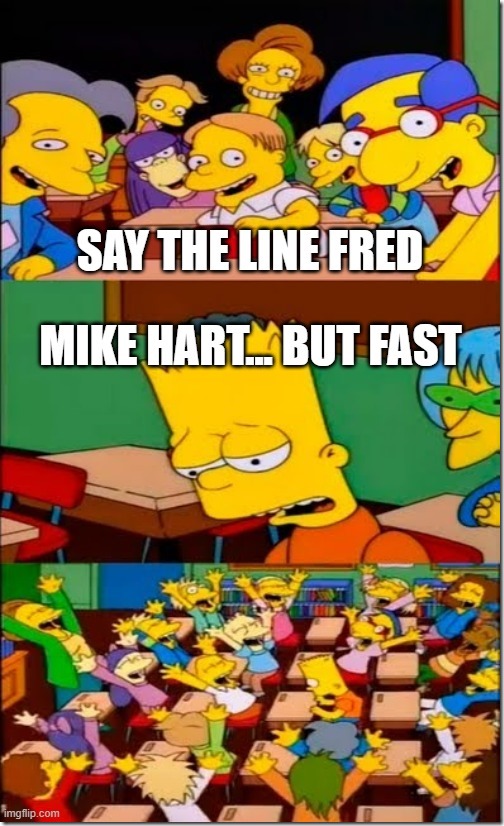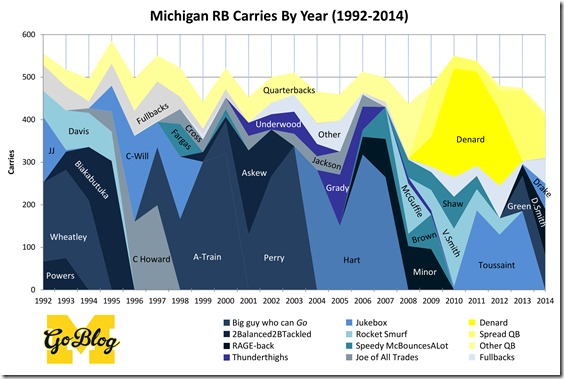running backs

Previously: Podcast 14.0A, 14.0B, 14.0C. The Story. Quarterback.
RUNNING BACK: AT LONG LAST, THE CHOSEN ONE
[Bolded player rules: not necessarily returning starter, but someone we've seen enough of that I'm no longer talking about their recruiting profile (much, anyway). Extant contributor.]
| FEATURE BACK | Yr. | SHORT YARDAGE | Yr. | THIRD DOWN | YR. |
|---|---|---|---|---|---|
| Blake Corum | Jr. | Kalel Mullings | So.* | Donovan Edwards | So. |
| Donovan Edwards | So. | Tavierre Dunlap | Fr.* | Blake Corum | Jr. |
| CJ Stokes | Fr. | Isaiah Gash | Fr.* | Isaiah Gash | Fr.* |
| Tavierre Dunlap | Fr.* | Alex Orji | Fr. | CJ Stokes | Fr. |
RATING: 5
ATTENTION MEDIA: did you know that Fred Jackson rejoined the Michigan football program this offseason? He's an analyst or somesuch. He's in the building. He is there for you, the quote-gathering media, to sidle up next to. Once you've sidled real good you can say "hey" or "psst," preferably in a large group. And then you can do this.
Anyway. BLAKE CORUM is the light and the truth. It is a longstanding UFR tradition to cluck ominously at Michigan's running backs, decrying their missed cuts and their… other missed cuts, moaning about how Mike Hart never would have ever done that why aren't you Mike Hart you filthy sonofa treasured student-athlete, &c. This did not happen in 2021.
[Paul Sherman]
Earlier this week Ace ran into an article on the Saquon Barkley pick and why, despite sabr-conventional wisdom, it might not have been such a bad idea after all. The article is Michigan-relevant for two reasons. One because he brings up the play where Barkley got manned up as a slot receiver on McCray and smoked him for the 4th quarter touchdown that officially made it a rout. Since that’s already seared into your memory and most everyone involved is now well out of Michigan’s sphere you don’t have to relive that part.
The second reason is because Michigan is stockpiling running backs again. At first blush you might dismiss that as an emphasis on running the football, but…
In 2017, according to Sharp’s data, the Patriots used “11” personnel on just 44 percent of their plays—tied for the fourth-fewest total in the league. New England’s second most-common personnel grouping? “21,” or two running backs, one tight end, and two wideouts, which the Pats used on 24 percent of their plays, second only to the 49ers’ 28 percent. Per Sharp, the Pats’ success rate out of “11” personnel was 47 percent. Out of “21” personnel, it was 60 percent.
…it also might be a sign that Harbaugh is staying at the head of the curve in the latest countermove of offensive progression.
IS MICHIGAN REALLY INVESTING IN RUNNING BACKS THAT MUCH?
The data say yes. Michigan returned five running backs this season and brought in three freshman. Next year they graduate one (Higdon), and are still in full pursuit of multiple targets, and not in the “we just need one of you” kind of way.
Nine running backs is over 10 percent of your scholarships. That is indeed a major investment. And when you look over Michigan’s history such an emphasis is indeed out of whack with the needs of Harbaugh’s modern predecessors. I was on the Daily when they peaked at seven in 2000 because they didn’t think they’d get both Chris Perry and Reggie Benton (and Carr held up his promise to Tim Bracken). And then it just turned out they had known, though didn’t say, that Justin Fargas and Ryan Beard weren’t going to be around for 2001; proving the anomaly, in two seasons they were down to just four.
The other example is Rich Rod’s first two years, though that includes Kevin Grady who moved to fullback. Still: Brandon Minor, Carlos Brown, Mike Cox, Teric Jones, Michael Shaw, Vincent Smith, and Fitz Toussaint were all on a roster together. We’ll come back to that one.
[After THE JUMP: Why all the backs?]
Fred Jackson has been a fixture at Michigan going back not one but two undefeated seasons. He arrived in 1992 to join Gary Moeller's staff. Since then, including a two-season stint as Lloyd Carr's first offensive coordinator, Jackson coached (and showered superfluous praise upon) over 100 running backs.
This site has correctly pointed out numerous flaws in the RBs over the last few seasons. It's difficult to diagnose what's coaching and what's just a certain back's ability. Every time we run into Vincent Smith, which is often, either Brian or I have pestered him about why nobody else can block like he could, and Vince just smiles and says "it's hard." Jackson himself has said that vision and ability are nature, blocking is a mentality, and the most he can really do is teach them whom to block.
| Best Backs of the Jackson Era | ||
|---|---|---|
| Player | Yds | YPA |
| Mike Hart | 5,040 | 4.97 |
| Anthony Thomas | 4,472 | 4.84 |
| Chris Perry | 3,696 | 4.56 |
| Tyrone Wheatley | 3,630 | 5.28 |
| Tshimanga Biakabutuka | 2,810 | 5.95 |
| Ricky Powers* | 2,554 | 4.86 |
| Fitzgerald Toussaint | 2,290 | 4.49 |
| Clarence Williams | 1,986 | 4.25 |
| Chris Howard | 1,876 | 4.49 |
| Brandon Minor | 1,658 | 5.01 |
| B.J. Askew | 1,580 | 4.61 |
| *Powers had another 1,945 yds at 5.07 YPA prior to Jackson's arrival | ||
What isn't hard to find is effusive praise about Jackson as a person and as a coach, from his former wards to high school coaches across Michigan. Like the coaches of Canham's era, Fred is a permanent fixture of the Michigan Athletic Department, a relationship that goes back to when Fred was Rick Leach's quarterbacks coach in high school.
The thing that really kept Jackson here through the tenure of four coaches was his ability to recruit the state of Michigan. There was a time when Michigan barely had to work to get homegrown kids, when Michigan Replay was the best access most local coaches had to any college football program, and the local press ignored anyone else. Today the in-state rival is on a roll, and there are as many Saban/Perles/Duffy/Dantonio guys in the state's coaching ranks as there are Michigan dudes. While Michigan's mainstream beat has four Rosenbergs trying to make a name for themselves at the expense of the program for every Angelique, the Spartans own an army of slappies. The current generation of recruits were born after the peak of Carr, and can only remember a few crazy 4-point wins over Notre Dame as great Michigan moments.
Michigan has veritably owned Michigan regardless.
This month, Jackson retired, the position he held for 23 years going to one of his first acolytes at Michigan. I choose not to let such a career pass quietly. I also choose not to review his career statistically, or at least not by utter performance. Rather, I'd like to chart our way through this long career in simple carries. Full data is here.
The bar graphs after the jump don't tell a story; they're there help jog the stories of so many storied running backs and fullbacks to come through here since I was 12.
[After the jump, a review of the backs in the Time of Jackson and the carry distribution between them from game to game.]





43